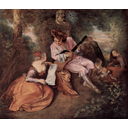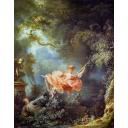Rococo Art
Rococo art was a popular style across Europe between the 1730s and 1760s, but its influences were mostly reduced to noble and royal palaces.
Architecture:
it is mostly shown in extremely overelaborate interiors of private salons and small cabinets:
Curves, seashells and floral elements are the most typical decorative elements. All together they are so-called rocaille. Mirrors are also very common in their decoration. It can be widely found in many Austrian and German royal palaces, such as Amalienburg (Munich). In Spain the best example is the Gasparini Salon in the Royal Palace of Madrid and some rooms in La Granja Palace.
Painting:
pastel colours are mostly used to depict mythological themes, rural festivals and domestic scenes. Watercolours are also used in this style. The French Watteau and Jean-Honoré Fragonard (The swing) are the most well-known Rococo painters, whilst in Spain the best Rococo painter is Luis Paret
Sculpture:
Rococo sculptures were often small, and represented joyfull and mythological themes. An excellent example is Bouchardon's Cupid.
Rococo Art
Al images can be found on Wikipedia CC BY-SA 4.0




